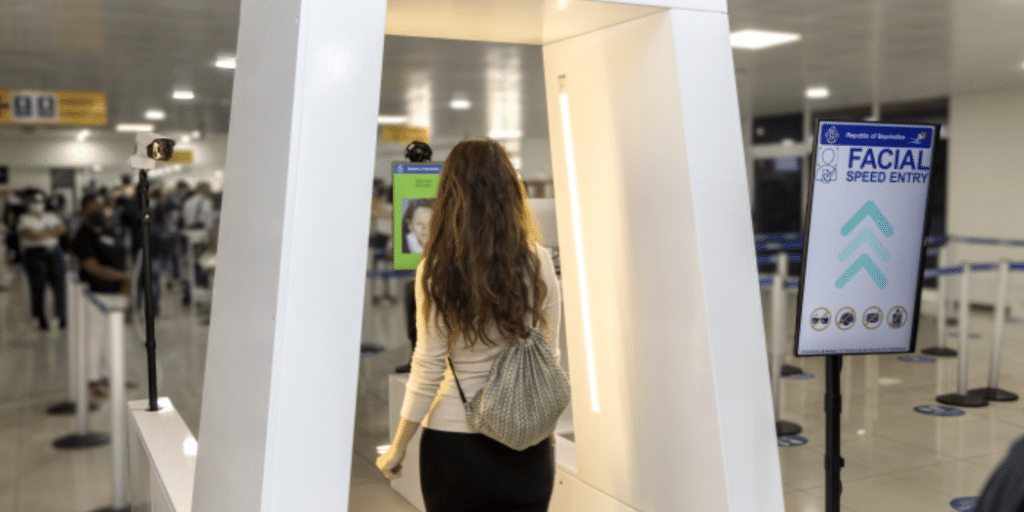How digital borders, biometrics, and new technologies are redefining how we move through the world.
From Enthusiastic Cynic to Cautious Optimist
Confession time: as an analyst, I describe myself as an enthusiastic cynic. I’m excited by innovation – new technologies, new approaches, and fresh ideas that promise to make travel smarter and smoother.
However, that excitement comes with realism. The best ideas may stumble not because the tech isn’t ready, but because the strategy, timing, or regulations aren’t aligned. The smartest solution can fail if it’s launched under the wrong conditions or with the wrong partners.
In our Airports + Borders coverage, two familiar challenges consistently appear: building consensus and navigating legacy regulation. Europe offers a perfect case study.
Europe Leads in Self-Service, Lags in Biometrics
Our Smart Airports Tracker shows that European airports lead globally in adopting self-service systems – self-bag drops, eGates, and kiosks. Yet when it comes to biometrics, they lag behind.
Our report, The Seamless Passenger Journey in Smart Airports, found that 47.8% of touchpoints in the Middle East are biometrically enabled, compared with just 37.1% in Europe.
The reason? Not technology – but policy. Guidance from the European Data Protection Board (EDPB) requires passenger consent at every touchpoint, limiting automation’s benefits and ROI. With less incentive, airports and airlines hesitate to invest. The result: fewer truly seamless, end-to-end biometric journeys in Europe compared to other regions.
Pushing Out the Border
At the border, though, the equation changes. National security often trumps privacy concerns, and biometric collection is frequently mandatory. This reality has spurred innovation focused on doing more before travellers arrive.
As part of research for our upcoming report, Smart Borders – the Future Evolution of Land, Sea and Air Borders, we’re exploring efforts to “push out the border.” The goal: complete more checks in advance, so less needs to happen at the checkpoint.
The results are clear – shorter queues, faster clearances, and more reliable data for pre-screening travellers. For destinations, it also means a smoother, more attractive arrival experience.
Digitising the Border Experience
Electronic travel authorisations (ETAs) have existed for years in countries like Australia, New Zealand, Canada, the U.S., Singapore, South Korea – but the trend is accelerating fast.
Malaysia launched its ETA in late 2023, Kenya in early 2024, and the UK began rolling out its system at the end of last year. In 2025 alone, Thailand, Papua New Guinea, and India were amongst those to follow this trend. The EU’s ETIAS for the Schengen Area is next, following the launch of the Entry/Exit System (EES).
Mobile apps are reshaping this process too, allowing travellers to complete authorisations easily, often by reading ePassport data via NFC. Some countries also verify those identities through a quick selfie – matching it to the passport photo stored in the chip.
It’s an increasingly competitive space, and we’re seeing a growing number of technology companies eager to expand or enter this market, several looking at API-PNR data capabilities as a means of entry.
Digital Travel Credentials: The Next Step Forward
The natural evolution of this trend is the Digital Travel Credential (DTC) – verified digital identity that combines a traveller’s personal, travel, and biometric data into a single secure package.
Border agencies can use DTCs to review and pre-clear travellers before arrival, turning today’s border checkpoint into a quick verification point rather than a bottleneck.
While standards and transmission protocols are still being refined, pilots are already live. The first Type 2 DTC trial is beginning in Europe, following several successful Type 1 tests. Leading players – SITA, Thales, and IDEMIA amongst others – are driving this evolution.
With these systems in place, low-risk travellers can be fast-tracked, while resources focus on those needing more attention. Which raises an intriguing question: if travellers are verified seamlessly as they move – do we still need eGates at all?
From Concept to Reality: DTC and Seamless Borders
Real-world examples are already proving what’s possible:
- Eurostar’s SmartCheck (with Entrust, iProov and Inverid) was the first commercial DTC service in 2023, enabling passengers to pass through biometric pods using a verified credential combining their passport and ticket.
- Curacao (Entrust and Amadeus) and Aruba (SITA) created the world’s first fully digital air borders—helping tourists go from “plane to beach” in under an hour.
- St. Kitts & Nevis, the Seychelles (both Travizory), and Sint Maarten (Amadeus) have deployed biometric corridors for faster arrivals.
- Dubai International Airport (Travizory) introduced its FaceLane biometric corridor, aiming to phase out eGates altogether.
- Australia is targeting a passport-free border by 2030, with live trials already underway.
- The UK has tested solutions from several companies, including Fujitsu and iProov systems, at ports, including for in-car verification similar to UAE land border pilots.
- Canada is proceeding with a pilot for smartphone-based digital passports with Entrust and Face4 Systems.
- Toppan Next Tech and Paravision have partnered on automated land borders combining biometric clearance of travellers with vehicle screening.
In Singapore, returning travellers can now re-enter the country using only stored biometrics—no passport required at ABC eGates. Even the land border with Malaysia now allows clearance via QR code for those enrolled.
Meanwhile, in the U.S., programs like Biometric Exit, Enhanced Passenger Processing (EPP), and Seamless Border Entry (SBE) are scaling rapidly. SBE, powered exclusively by iProov, now operates in 9 airports (including one EPP). iProov built strong early momentum with the CBP and we expect this double next year, whilst 17 airports have implemented EPP with BigBear.ai technology.
Different Approaches for Different Tiers of Travellers
All of these developments show how border experiences are evolving for travellers across land, sea, and air.
eGates have long been the cornerstone of airport automation, but land and sea borders – with their more variable conditions and environments – have been slower to adapt. That’s beginning to change.
Future border strategies will be built on tiered authentication, using risk-based models to decide how travellers are processed. Low-risk travellers may move through biometric corridors; others may use eGates or undergo manual inspection.
The aim is universal: focus resources where they’re most needed, minimise queues, and enhance security in a faster, more efficient way.
Looking Ahead
The border of the future won’t be a single line to cross—it will be a connected, intelligent ecosystem that begins before a journey starts and ends only when the traveller reaches their destination.
As digital credentials, biometrics, and data-sharing mature, the traditional passport queue could soon become a relic of the past.
The challenge ahead isn’t just technological—it’s human. It’s about building trust, aligning regulations, and ensuring that innovation serves everyone, safely and seamlessly.

John Devlin, Senior Research Consultant








